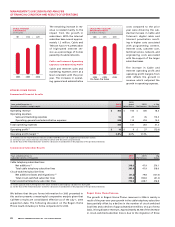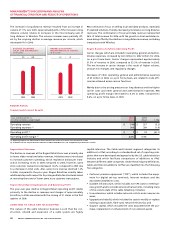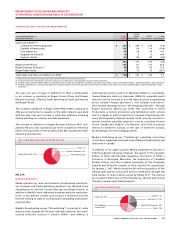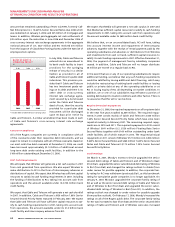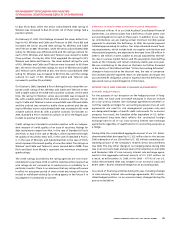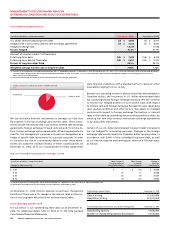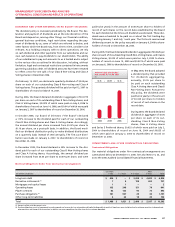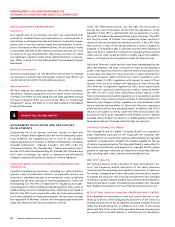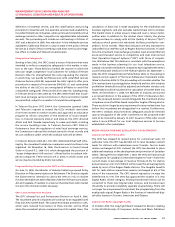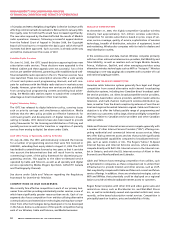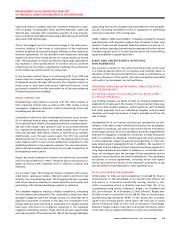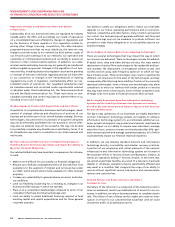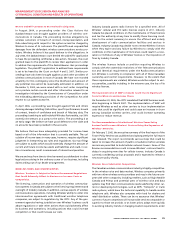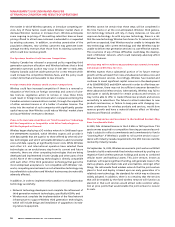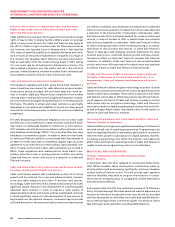Rogers 2006 Annual Report Download - page 52
Download and view the complete annual report
Please find page 52 of the 2006 Rogers annual report below. You can navigate through the pages in the report by either clicking on the pages listed below, or by using the keyword search tool below to find specific information within the annual report.
48 R OGE RS C OMM UNI C ATION S I N C . 20 0 6 AN N UA L R EPOR T
MANAGEMENT’S DISCUSSION AND ANALYSIS
OF FINANCIAL CONDITION AND RESULTS OF OPERATIONS
OFF-BAL ANCE SHEET ARRANGEMENTS
Guarantees
As a regular part of our business, we enter into agreements that
provide for indemnification and guarantees to counterparties in
transactions involving business sale and business combination agree-
ments, sales of services and purchases and development of assets.
Due to the nature of these indemnifications, we are unable to make
a reasonable estimate of the maximum potential amount we could
be required to pay counterparties. Historically, we have not made
any significant payment under these indemnifications or guaran-
tees. Refer to Note 24 to the 2006 Audited Consolidated Financial
Statements.
Derivative Instruments
As previously discussed, we use derivative instruments to manage
our exposure to interest rate and foreign currency risks. We do not
use derivative instruments for speculative purposes.
Operating Leases
We have entered into operating leases for the rental of premises,
distribution facilities, equipment and microwave towers and other
contracts. The effect of terminating any one lease agreement would
not have an adverse effect on us as a whole. Refer to “Contractual
Obligations” above and Note 23 to the 2006 Audited Consolidated
Financial Statements.
4 OPERATING ENVIR ONMENT
GOV E R N ME N T REGU L AT I O N A N D R EGUL ATO RY
DE V E LOPM E N T S
Substantially all of our business activities, except for Cable and
Telecom’s Rogers Retail segment and the non-broadcasting opera-
tions of Media, are regulated by one or more of: the Canadian
Federal Department of Industry, on behalf of the Minister of Industry
(Canada) (collectively, “Industry Canada”), the CRTC under the
Telecommunications Act (Canada) (the “Telecommunications Act”)
and the CRTC under the Broadcasting Act (Canada) (the “Broadcasting
Act”), and, accordingly, our results of operations are affected by
changes in regulations and by the decisions of these regulators.
CANADIAN R ADIO-TELEVISION AND TELECOMMUNIC ATIONS
COMMISSION
Canadian broadcasting operations, including our cable television
systems, radio and television stations, and specialty services are
licenced (or operated pursuant to an exemption order issued) and
regulated by the CRTC pursuant to the Broadcasting Act. Under the
Broadcasting Act, the CRTC is responsible for regulating and super-
vising all aspects of the Canadian broadcasting system with a view to
implementing certain broadcasting policy objectives enunciated in
that Act. The CRTC is also responsible under the Telecommunications
Act for the regulation of telecommunications carriers which includes
the regulation of Wireless’ cellular and messaging operations and
Cable and Telecom’s Internet and telephone services.
Under the Telecommunications Act, the CRTC has the power to
exempt any class of Canadian carrier from the application of the
legislation if the CRTC is satisfied that such an exemption is consis-
tent with Canadian telecommunications policy objectives. The CRTC
also has the power to forbear from regulating certain services or
classes of services provided by individual carriers. If the CRTC finds
that a service or class of services provided by a carrier is subject to
a degree of competition that is sufficient to protect the interests of
users, the CRTC is required to forbear from regulating those services
unless such an order would be likely to unduly impair the establish-
ment or continuance of a competitive market for those services.
Cable and Telecom’s retail services have been deregulated by the
CRTC. Nevertheless, the CRTC continues to retain broad regulatory
powers over Cable and Telecom under the Telecommunications Act,
in particular with respect to interconnection to Cable and Telecom’s
networks. However, Cable and Telecom’s major competitors, ILECs,
remain subject to CRTC regulation with respect to many of their
services. How the ILECs comply with regulation as well as how the
CRTC enforces its regulation against the ILECs could impact Cable
and Telecom’s operations and financial condition. Because neither
the CRTC nor the courts have interpreted certain aspects of the
Telecommunications Act and its regulations, it is impossible to predict
what impact, if any, these provisions will have on Cable and Telecom.
Moreover, any change in policy, regulations or interpretations could
have a material adverse effect on Cable and Telecom’s operations
and financial condition and operating results. In addition, the CRTC’s
decisions are subject to review under the Telecommunications Act
at any time and may be appealed to the Federal Court of Appeal
(Canada) within 30 days of a decision or challenged by a petition to
the Federal Cabinet of Canada within 90 days of a decision.
COPYRIGHT BOARD OF CANADA
The Copyright Board of Canada (“Copyright Board”) is a regulatory
body established pursuant to the Copyright Act (Canada) (the
“Copyright Act”) to oversee the collective administration of copyright
royalties in Canada and to establish the royalties payable for the use
of certain copyrighted works. The Copyright Board is responsible for
the review, consideration and approval of copyright tariff royalties
payable to copyright collectives by Canadian broadcasting undertak-
ings, including cable, radio, television and specialty services.
INDUSTRY CANADA
The technical aspects of the operation of radio and television sta-
tions, the frequency-related operations of the cable television
networks and the awarding and regulatory supervision of spectrum
for cellular, messaging and other radio-telecommunications systems
in Canada are subject to the licencing requirements and oversight
of Industry Canada. Industry Canada may set technical standards for
telecommunications under the Radiocommunication Act (Canada)
(the “Radiocommunication Act”) and the Telecommunications Act.
RESTRICTIONS ON NON -C ANADIAN OWNERSHIP AND CONTROL
Non-Canadians are permitted to own and control directly or indi-
rectly up to 331/3% of the voting shares and 331/3% of the votes of a
holding company which has a subsidiary operating company licenced
under the Broadcasting Act. In addition, up to 20% of the voting
shares and 20% of the votes of the operating licencee company may
be owned and controlled directly or indirectly by non-Canadians.


